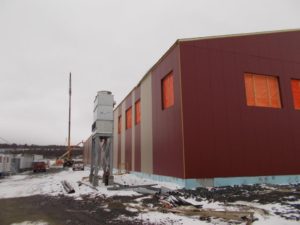
A variation of the traditional design and construction process began to evolve in Canada about twenty years ago. It was extolled as shortening the front-end work and getting to a fixed contract price much earlier in the game.
Commonly known as “Design-Build”, this delivery method involves determining the architectural (functional) program and an overall concept together with multi-disciplinary performance specifications for detailed design and construction. This outline information is then tendered, usually to invited “Design-Build” contractors who have been pre-qualified as capable of delivering the project under consideration. The tender time however can be quite protracted, as each contractor is responsible to put together an exclusive consultant team to develop a preliminary design of sufficient detail that it can be priced with reasonable accuracy. The tenders are then evaluated using various parameters, not the least of which is cost.
So, in theory, the project may not necessarily be awarded based on lowest price. The client typically (but not always) offers each team a stipend to prepare the design. Unfortunately, this is often less than the value of the work effort associated with the bid (even at cost). If you lose, you get the stipend. If you win, you get the job. The winning team then has to complete the detailed design so that construction can begin. Because the cost is set, the builder can undertake the work immediately (as he/she assumes associated risk). In most cases for example, the building footprint is frozen, and therefore excavation and foundations can begin while other design work is ongoing and shop drawings are prepared.
So that’s the gist of “Design-Build”. Don’t ask me why the “Bid” part was dropped when the bid portion is now lengthened and far more critical.
As in most projects, the client has great aspirations and insufficient budget. But unlike the traditional Design-Bid-Build delivery, tenders are not locked in. The client can chose to award and then negotiate project cost with the winning bidder. This negotiation process allows politicians and bureaucrats to nail down a cost that reflects the funding announcement as opposed to being embarrassed by an immediate cost overrun. Invariably the project quality or functionality is compromised, sometimes severely, in order to save political face.
Design-Build is uncommon in the private sector. This is largely because of the reasons cited above. Design-Builders also tend to be large multi-national construction companies. They have the ability and resources to absorb up-front costs and organize a compliant response. Their size allows them to take on risk.
The Department of National Defence was one of the first to exploit Design-Build in Canada – and they were very good at it. They understood the concept of performance specifications and had the expertise to enforce those specifications during detailed design and subsequently, into construction.

Our provincial government began to experiment with Design-Build about fifteen years ago – and made a complete balls of it. It was attractive because the bureaucrats felt it could control cost. They would not have to make the dreaded trip upstairs to the Minister with bad news. We then saw politicians hail the delivery method as pivotal in controlling public expenditure – politicians who had absolutely no clue as to what they had given up in terms of building quality, functionality, sustainability, or dare I say, architecture.

Worse still, Transportation and Works (responsible for most building in Newfoundland and Labrador) went into Design-Build thinking that they could mold it into something that better suited their liking. (Think never worked in the private sector and the picture will start to come into focus.) Because they had gone through great effort to come up with a master specification that they enforced for all building projects, they insisted on using it. The fact that it was totally prescriptive as opposed performance-based didn’t seem to click with them. (Uniformat II or ASTM E1557 is the proper format for this, but I am getting into detail here – something that T&W never bothered to do.)
They also felt it was perfectly fine to allow the consultants who assembled the Design-Build documents on behalf of government, to bid the project with contractors. (If I get into how misguided this idea was, the internet-of-things may be overwhelmed.) Typically under Design-Build, the “front-end” or “advocate” consultants are retained by the client in order to ensure quality. Not to worry. Our civil service was chock full of construction expertise.
Finally, the provincial government truly believed that consultants would do a completely objective job keeping the builder in check.
Hellooo!!! We work for the builder. He pays our invoices. Duh.
So here in Newfoundland and Labrador, Design-Build led to an era of buildings that are, to be complimentary, fit-for-purpose at best. Perhaps not a bad thing in an economy that is on the verge of bankruptcy. Not a good thing for architecture however. When Design-Build projects were over budget, there was an easy fix. Just tell the lowest-bid contractor that if they wanted the job, shave off a couple of million bucks. Despite pie-in-the-sky architectural goals pertaining to aesthetic objectives or sustainable targets, the vast amount of this money was typically extracted from the architectural budget. The engineering disciplines rarely got fingered. (You can’t learn engineering by watching HGTV, but apparently, you can learn all you need to know about architecture.)
So what is the architectural impact for most projects? Well here is the proverbial “artist’s rendering” of a project I designed in 2014. It’s the new arena / wellness centre in Harbour Grace. This design addressed all the program requirements.

Now feast your eyes on what you get once the architectural effort has been pillaged by bureaucrats through the magic of Design-Build. But it’s just a hockey rink right? No big deal. It’s taxpayer’s money. Keep it cheap and dirty … and ugly. (And FYI – I didn’t pick the colours!)

So Design-Build is here to stay – for all the right reasons. Just ask any pandering, ribbon-cutting, re-announcing, best-bang-for-your-dollar politician.
No bureaucrats were harmed in making of this building.
